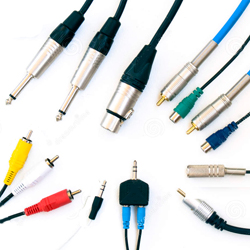
Mic to Line Bridging Barrels. These contain a transformer that coverts mic level to line level, or line level to mic level. using XLR input and output connectors.
They’re quite useful for interfacing the line level output of a console in a breakout room with the house system that only has a mic level input connector, or when interfacing a line level aux output with a camera’s mic input.
DI Boxes. An industry staple for converting high-impedance instrument signal into low-impedance mic signal. DIs come in two basic varieties: active and passive. Active boxes contain electronic circuitry that requires power from a battery or phantom power from a console.
Passive boxes use a transformer to convert the signal and do not require power. Many DI boxes offer ground lift switches and “loop-through” outputs so they can be inserted between the instrument and the stage amplifier. Single channel units are the most common, but DIs with multiple channels are available.
Isolation (ISO) Transformers. Available in both barrel and box form and using a “1 to 1” transformer that breaks the physical connection in an electric signal path, removing any hum and buzz caused when two components are plugged into different power sources or when using a cable that has picked up EMI.
Many of the box units are available in multiple channel versions, and some offer a variety of connection options so they also act as interface adapters in addition to isolation transformers.
I keep a variety of ISO transformers in my kit because I do a lot of corporate work where to my equipment interfaces with the house system and/or broadcast and recording trucks, which are all on different power sources and therefore more susceptible to hum and buzz issues.
Ground Lifts. Many times an ISO transformer isn’t needed and a simply lifting of the ground at the input side of the connection solves the noise issues (in a balanced connection).
PAD Adapters (“PADs”). They pad or reduce signal by a preset or adjustable level.
Pin 2 To 3 Adapters. Before the industry adopted Pin 2 as Hot as the standard, some equipment used Pin 3 as Hot. I still have some older amplifiers that use the Pin 3 configuration and occasionally run into rental or installed gear with the same thing. These adapters simply swap Pin 2 and Pin 3, solving any polarity issues.
Splitters. Boxes or cables for splitting a signal into two or more streams. The most common use is with intercom systems. Instead of needing to daisy-chain every comm belt-pack, a splitter can be used to send “home runs” to the different tech areas.
Combiners. Boxes that combine two or more signals into a single signal. Some DI boxes have a combine feature that allow joining two line level signals into a single mic level signal. This comes in handy for taking a stereo signal from a computer but there’s a limited number of inputs or snake channels.
Barrel Joiners. Technically turnarounds, but they’re designed to join cables that use the same gender connector at each end, like RCA or 1/4-inch and SpeakON loudspeaker cables. There are also loudspeaker level splitters available for joining multiple cables to a single amplifier output.
Network Switches. With Dante digital networking becoming the norm for signal transport, I carry a few 4 port Gigabit switches with me that allow me to more easily set up and route signals across a show network.
Routers or WAPs (Wireless Access Points). I carry a small wireless router that interfaces my iPad with various consoles, giving me the ability to walk around and mix remotely with an app.
